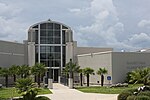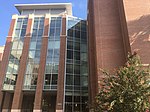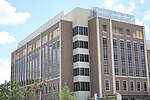Condron Ballpark

Condron Family Ballpark at Alfred A. McKethan Field is the college baseball stadium of the University of Florida, and serves as the home field for the Florida Gators baseball team. Condron Ballpark is located on the university's Gainesville, Florida campus, adjacent to the university's softball stadium, Katie Seashole Pressly Stadium, and its lacrosse stadium, Dizney Stadium. It replaced the former ballpark, Alfred A. McKethan Stadium at Perry Field, which had been the home of Florida baseball from 1988 through 2020; McKethan Stadium's earlier incarnation, known simply as Perry Field, had been the home field of Gator baseball since 1949. The stadium opened on February 19, 2021, when the Gators hosted Miami in their season opener.
Excerpt from the Wikipedia article Condron Ballpark (License: CC BY-SA 3.0, Authors, Images).Condron Ballpark
Hull Road, Gainesville
Geographical coordinates (GPS) Address Nearby Places Show on map
Geographical coordinates (GPS)
| Latitude | Longitude |
|---|---|
| N 29.636374 ° | E -82.363786 ° |
Address
Left Field Berm
Hull Road
32612 Gainesville
Florida, United States
Open on Google Maps










